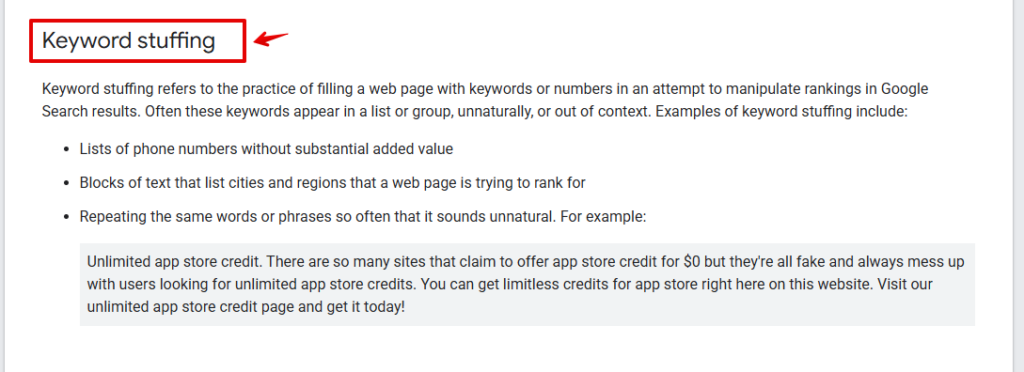Understanding Keyword Stuffing in SEO
Keyword stuffing refers to the practice of overloading a web page with specific keywords in an attempt to manipulate a site’s ranking in Google’s search results.
This technique can actually hinder your SEO efforts rather than help.
While keywords play a critical role in SEO, overusing them goes against modern SEO best practices.
Why Keyword Stuffing Is Detrimental
From an SEO perspective, keyword stuffing is frowned upon by most search engines.
Google, in particular, has evolved to recognize excessive keyword usage, penalizing sites that engage in this practice.
Google’s own documentation already warns us that this practice is considered spam:

The days when search engine algorithms primarily focused on keyword frequency are long gone. Now, search engines prioritize relevance and user experience.
User experience suffers greatly due to keyword stuffing. Pages filled with repetitive or forced keywords tend to have awkward, unreadable content, leading to a poor visitor experience.
This results in high bounce rates and can ultimately decrease your site’s authority and trustworthiness.
What Does Keyword Stuffing Look Like?
Keyword stuffing can be quite apparent if you know what to look for. In many cases, it involves inserting lists of keywords or numbers in an unnaturally forced way throughout the content.
Additionally, keyword stuffing can occur in meta tags and alt attributes, where keywords might be used excessively but don’t accurately describe the content or image.
This practice can lead to poor indexing and relevancy issues.
The Evolution of Search Engine Algorithms
Search engines have become increasingly adept at detecting keyword stuffing.
Google’s algorithms, such as Panda and Hummingbird, emphasize content quality and context.
They focus more on understanding user intent and delivering results that best match that intent, rather than emphasizing exact keyword match.
Latent Semantic Indexing (LSI) helps search engines understand related terms and the overall theme of the content rather than just individual keywords.
Therefore, content creators must diversify language and use synonyms and related terms naturally in the context.
Effective SEO Without Keyword Stuffing
Successful SEO strategies no longer rely on keyword density.
Instead, focus on high-quality, relevant content that addresses the needs of your audience. Engage with your readers by providing valuable information and insights, knowing that search engines reward comprehensive and informative content.
Use keywords strategically by placing them in essential locations such as titles, headers, and introductory sections.
Rather than repeating the same keywords, emphasize semantic relevance. Incorporate LSI keywords and phrases that naturally support your primary keywords within the content.
DinoRANK: A Unique Approach to SEO
When working with an SEO toolset like DinoRANK, it’s crucial to utilize their features to enhance organic search performance while avoiding outdated practices like keyword stuffing.
DinoRANK offers a suite of tools such as keyword research, content analysis, and TF-IDF analysis to help you identify the most effective keywords and phrases without resorting to stuffing.

The platform provides keyword recommendations based on semantic relevance, enabling you to craft content that aligns with current SEO standards.
Additionally, DinoRANK’s intuitive interface makes it easy to visualize key data such as internal link analysis and page rank, ensuring your overall SEO strategy is robust and comprehensive.


